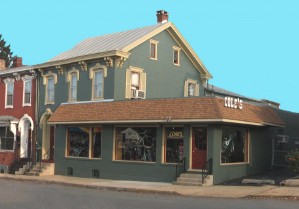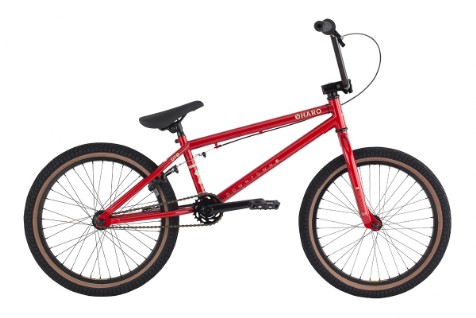BMX - Cole's Bicycles, Inc.






(717) 249-3833
Main menu:
Knowledge > Bike Styles
BMX Bikes

BMX Race Bikes
BMX race bikes have their brake mounts located on top of the seatstays. This enables running a more powerful-braking linear-pull brake. Notice also how the chainring is rather large. This helps distribute the pedal force over more chain links and is safer when you’re loading up the pedals with pressure waiting for the gate to drop at the start of a race.
BMX race bikes also come in different frame sizes. Our chart below shows the approximate fit based on rider age. Final fitting is best done in our store. Also, the Pro and Expert bikes are sometimes available in XL (Extra Long) sizes as well.
BMX bikes are popular with kids because of their small size, but they are used by adults and kids alike for various styles of trick and stunt riding.
True BMX bikes started back in the late sixties. They were knockoffs of motocross motorcycles and were designed for racing over jumps and around berms in the dirt. Pretty soon kids everywhere had them, racers or not.
BMX bikes are still designed for racing, although you don't have to race to enjoy their nimble and precise handling. They have 20-inch wheels, 2- or 4-piece handlebars, small seats, long cranks and strong rear hand brakes. The frames are light and sturdy, and the higher the price, the lighter they get.
BMX bikes are generally made of chromoly steel or aluminum. Chromoly frames are a bit heavier and more economical. Aluminum frames are lighter and are often made of oversize or exotically shaped tubing. Besides weighing less, aluminum is also rustproof. So, if you scratch your frame, there's no need to rush to touch it up.
| Size | Description | Fits |
| Mini/Micro | Low stand-over height, 130 to 145-mm cranks, 20 x 1 1/8-inch tires | 4 to 6 years old |
| Junior | Slightly larger frame than Mini, 145 to 160-mm cranks, 20 x 1 1/8- to 20 x 3/8-inch tires | 6 to 9 years old |
| Expert | Longer top tube than Junior, 160- to 170-mm cranks, 20 x 1.5- to 20 x 1.75-inch tires | 9 to 13 years old |
| Pro | "Full-size" frame, 175- to 180-mm cranks, 20 x 1.75- to 20 x 2.0-inch tires | 12 and up |
There are 3 general types of BMX bikes, Dirt Jump, Street and Park - Race - and Flatland.
Dirt Jump, Street and Park BMX
These 20-inch bikes are made of steel and are built sturdy, which means they're slightly heavier than racing BMX bikes. However higher-end models use superior grade steel and specially tapered tubes so they wind up being fairly light with excellent riding characteristics.
One feature you may find on park and street BMX bikes, but that’s prohibited on BMX race bikes, are pegs. These steel cylinders bolt onto your wheels and allow you to grind or stall on coping and rails. If you want to run pegs it’s a good idea to use a 14-mm rear axle, which is beefier than the 3/8-inch axle on a race bike. This axle will better handle the forces exerted by the pegs.
You'll also find a slightly easier gear ratio on these bikes. Since you won’t be sprinting as fast as possible, this ratio is easier to pedal and kinder on your knees. You’ll also appreciate the smaller chainring in the park when you're dropping in on a vert wall or trying lip tricks and disaster airs. A smaller chainring is less likely to hang up on the coping.
In general the street/park 20-inch bike is a great option to go with if you’re just not sure what you want. You can always race this bike, just make sure to remove your pegs. And you can charge it at the dirt jumps, on ramps and in the street. It’s definitely the most versatile of the three styles.
You'll also find a slightly easier gear ratio on these bikes. Since you won’t be sprinting as fast as possible, this ratio is easier to pedal and kinder on your knees. You’ll also appreciate the smaller chainring in the park when you're dropping in on a vert wall or trying lip tricks and disaster airs. A smaller chainring is less likely to hang up on the coping.
In general the street/park 20-inch bike is a great option to go with if you’re just not sure what you want. You can always race this bike, just make sure to remove your pegs. And you can charge it at the dirt jumps, on ramps and in the street. It’s definitely the most versatile of the three styles.
Flatland BMX Bikes
The flatland bike is the most specialized of all the 20-inch bikes. The unique frame geometry and components generally keep it relegated to its natural terrain, which, as you guessed, is flat land. This style of riding has been described as the break dancing of biking — it is truly amazing. The riders are constantly in motion as they balance on their bike and manipulate it into different positions producing wild tricks.
In order to be able to move the bike into such precarious situations, a flatland frame is much smaller than a standard BMX frame. In turn the wheelbase is shorter, which allows the rider to whip the bike around easily. The top tube and down tube also have a unique styling that gives the rider extra clearance to move on the bike.
Notable component differences are the freecoaster hub and the zero-offset fork. A freecoaster hub allows the rear wheel to spin backward without engaging and turning the cranks. This allows the rider to roll any direction and maintain the same foot orientation — great for balance and tricks. And the zero-offset fork puts a direct line of pressure from the handlebars into the front-wheel axle. This creates an ideal balance point for the front end of the bike.
Flatland bikes run an array of brake setups. Most commonly you'll find both a front and rear U-brake. In this case, a cable detangler is necessary to keep the brake cable from winding around the frame when doing tricks like bar spins. However, there are some flatland riders that use only a front brake, a rear brake or no brakes at all.
You’ll also find that flatland bikes run four pegs, the crankarms are short, the seatpost is long and the tires are slick and inflated very high. As you can see, flatland 20-inch bikes have everything you need to pull off unique tricks back-to-back.
Home | About Us | Bicycles & Gear | Service | Events | Specials | Contact / Hours | Knowledge | General Site Map
